Helen Gibson
Helen Gibson (August 27, 1892 – October 10, 1977) was an American film actress, vaudeville performer, radio performer, film producer, trick rider and rodeo performer; and is considered to be the first American professional stunt woman.[1]
Helen Gibson | |
|---|---|
 Gibson circa 1920 | |
| Born | Rose August Wenger August 27, 1892 |
| Died | October 10, 1977 (aged 85) |
| Occupation | actress, stuntwoman, trick rider, film producer |
| Spouse(s) | Hoot Gibson (1913–1920) Clifton Johnson (1935–1977) |
Rodeo riding
She was born Rose August Wenger in Cleveland, Ohio, one of five girls to Swiss-German parents, Fred and Annie Wegner.[2] Her father had wanted a son, and encouraged her to be a tomboy. Helen saw her first Wild West show in Cleveland in the summer of 1909 and answered a Miller Brothers 101 Ranch ad for girl riders in Billboard magazine. They taught her to ride, and she performed in her first 101 Ranch Real Wild West Show in St. Louis in April 1910. Said Helen: "(I) was already practicing picking up a handkerchief from the ground at full gallop. When veteran riders told me I could get kicked in the head, I paid no heed. Such things might happen to others, but could never happen to me, I believed. We barnstormed all over the US and the season ended all too soon. I was sorry when I had to go home, and could hardly wait to open in Boston in the spring of 1911."[3]
Hollywood
Cowboy extra
When the Miller-Arlington Show suddenly closed in 1911, it left many performers stranded in Venice, California.[4] Thomas H. Ince, who was producing for the New York Motion Picture Company, hired the entire cast for the winter at $2,500 a week. The performers were paid $8 a week and boarded in Venice, where the horses were stabled. They rode five miles each day to work in Topanga Canyon, where the films were being shot. In 1912, she made $15 a week for her first billed role as Ruth Roland's sister in Ranch Girls on a Rampage.[5]
Like many of the cowboy extras, Helen continued to perform in rodeos between pictures. At the Second Los Angeles Rodeo in 1913, she was featured in the Standing Woman Race, and so impressed one of the investors that he offered to finance a tour of rodeos for her, paying all expenses and splitting the winnings. At his ranch outside of Pendleton, Oregon, Helen worked his horses every day, and learned new forms of trick riding. In Pendleton in June 1913, she met Edmund Richard "Hoot" Gibson (1892-1962). They began working together, and at a rodeo in Salt Lake City, they won everything – the relay race, the standing woman race, trick riding, and Hoot won the pony express race, but the promoter of the rodeo skipped town and they did not get a cent of the prize money.[3]
Hoot Gibson
That summer, the couple performed in rodeos in Winnipeg, Manitoba, Canada, and Boise, Idaho, and arrived back in Pendleton a few days before the Pendleton Round-Up was due to begin. However, because rooms were almost impossible to obtain, they decided to "tie the knot" as married couples were given preference, and as a result the landlady gave them her own room. They won enough money to return to Los Angeles, where Hoot worked as a cowboy extra and double for Tom Mix, at the Selig Polyscope Company in the Edendale district of Los Angeles (now known as Echo Park). Helen also worked for Selig and for the Kalem Studios in Glendale.[3]
Stunt doubling
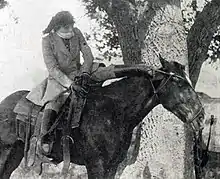
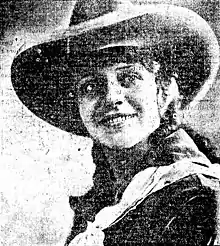
In April 1915 while on the Kalem payroll doubling for Helen Holmes in The Hazards of Helen adventure film series, Helen performed what is thought to be her most dangerous stunt: a leap from the roof of a station onto the top of a moving train in the A Girl's Grit episode. The distance between station roof and train top was accurately measured, and she practiced the jump with the train standing still. The train had to be moving on camera for about a quarter mile and its accelerating velocity was timed to the second. She leapt without hesitation and landed correctly, but the train's motion made her roll toward the end of the car. She caught hold of an air vent and hung on, dangling over the edge to increase the effect on the screen. She suffered only a few bruises.
The real difficulty of the stunt lay not in the leap itself, since she had practiced this with the train stationary and it clearly presented no difficulties, but in the timing. What such stunts require is an inbuilt awareness of the speed of the moving object. During the course of a leap where a moving object is concerned, the spatial relationship between take-off point and landing point changes. It is quite possible to imagine a leap from a static take-off point on to the roof of a moving train in which the stuntman aims to land halfway along a carriage roof yet in fact-because of the speed of the train-lands in the gap between two carriages. It seems that in such a leap the safest place to aim at is the gap itself At least in that way one can guarantee to miss it. Helen Gibson had this sensitivity to spatial relationships between objects in motion, but it is certainly not a gift shared by all stuntmen." Arthur Wise from Stunting In the Cinema, 1973.[6]
Hazards of Helen
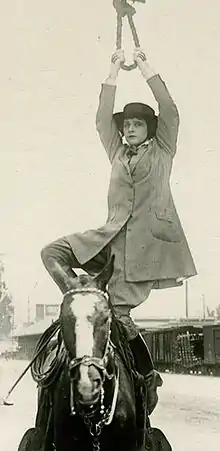
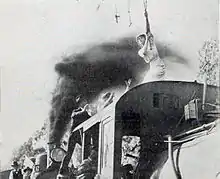
Considered the longest serial in history, the 119 episodes of The Hazards of Helen are stand-alone stories, instead of chapters. The highly successful series had begun with Helen Holmes in the lead role for the first 49 episodes, but Helen Gibson was given her chance to replace Holmes for two pictures when she took ill, and starred in A Test of Courage and A Mile a Minute, for $35 a week. The Kalem New York office personnel were so impressed by her work, they instructed Glendale to keep her on when Helen Holmes and her husband, Hazards of Helen director, J. P. McGowan, left to form their own company.
Now rechristened 'Helen' by the studio, she proved to be a capable actress, and after making several more pictures she wrote a story for a one-reeler that was built around a risky stunt. To catch a runaway train, she would detach a team of horses, ride them "standing woman", and then catch a rope dangling from a bridge and use it to swing from the horses and onto the train as it came under the bridge. Kalem rewarded her by raising her salary to $50 a week.[3]
Gibson performed in The Hazards of Helen for 69 episodes until the series ended in February 1917, after which Kalem tried producing another serial The Daughter of Daring, with a starring role for her.[8] One of her best stunts appeared in this serial: traveling at full speed on a motorcycle chasing after a runaway freight train, Gibson rode through a wooden gate, shattering it completely, up a station platform, and through the open doors of a boxcar on a siding, with her machine traveling through the air until it landed on a flatcar in a passing train. The trick was to undercrank the camera and execute it all with flawless timing.[9]
By then Kalem, a producer of single-reel films, was in decline and rather than risking financial failure producing feature films, ceased production in 1917 and was sold to Vitagraph.[10] Universal offered her a three-year contract at $125 a week for two-reel, and five-reel pictures until 1919; among these were two 1919 John Ford films, Rustlers and Gun Law. Her Universal contract ended with the winter of 1919 and she signed with Capital Film Company for $300 a week, but Capital was already losing money and went out of business in May 1920.
Hoot Gibson, who had joined the Army tank corps, returned during Christmas 1918 and Universal gave him a contract to appear in two-reel Westerns. He found his wife had become a very successful movie star while he was away, but his ego could not handle it, and the couple separated in 1920. Census records for 1920 indicate that they were living separately; Hoot Gibson listed himself as married, and Helen listed herself as widowed.[11] In 1922, Hoot married a woman named Helen Johnson, who is often confused with Helen Gibson. In 1923, Hoot and Helen Johnson Gibson had their only child, Lois Charlotte Gibson, and divorced in 1930.
Producer
In 1920, Gibson created Helen Gibson Productions to produce her own starring vehicles. The first was to be No Man's Woman, a Western melodrama about a kind-hearted dance-hall hostess rescuing a rancher's child. The money gave out before the picture was finished, and it bankrupted Gibson personally. A year later, the film was released by another studio with a new title, Nine Points of the Law. In March 1921, the Spencer Production company hired Gibson to star in The Wolverine. They were so pleased with her performance, they put her on the payroll at $450 a week. However, before shooting began on her second picture, her appendix ruptured, putting her in the hospital battling peritonitis. The studio replaced her.[5][12]
Trick riding
After her recovery from surgery, Gibson's popularity as a lead had waned. In September 1921, an independent company hired her for a five-reeler and folded without paying the cast or crew. Riding in the picture put Gibson back in the hospital, forcing her to sell her furniture, jewelry, and car. She made personal appearances in connection with bookings of No Man's Woman and |The Wolverine in theatres and at rodeos, including visiting her old friends at the 101 Ranch in Ponca City, Oklahoma.
In the spring of 1924, Gibson got a job trick riding with Ringling Bros. and Barnum & Bailey Circus' Wild West show, along with other cowboy performers such as Ken Maynard,[6] and performed in their 'after show' for two-and-a-half years.[5] In September 1926, Gibson joined a Hopi Indian act and worked the Keith Vaudeville Circuit out of Boston.[3]
Return to Hollywood
She returned to Hollywood in 1927 and began doubling for stars such as Louise Fazenda, Irene Rich, Edna May Oliver, Marie Dressler, Marjorie Main, May Robson, Esther Dale, and Ethel Barrymore. She worked constantly stunt doubling and in uncredited or bit parts.[5] As she had in her heyday, Helen became a featured guest at benefit rodeos and events such as the Annual Santa Barbara Horse Show.[13]
In 1935, Helen married Clifton Johnson,[1] a studio electrician who had been a chief gunner in the Navy. In 1940, he asked for active duty, and while he was serving in World War II, she carried on working as an extra and became treasurer of the stunt girl's fraternal organization.[14]
In Universal's Hollywood Story (1951), she was cast as a retired silent film actress alongside Francis X. Bushman, William Farnum, and Betty Blythe, and earned $55 for one scene. Tony Curtis, then unknown, was assigned to escort Gibson and Blythe to the premier at the Academy Award Theater at the Academy's then-headquarters on Melrose Avenue in Hollywood, where the Hollywood Chamber of Commerce gave each silent star a plaque "for your outstanding contribution to the art and science of motion pictures, for the pleasure you have brought to millions over the world, and for your help in making Hollywood the film capital of the world."[3]
Retirement
Gibson continued to take character parts and extra work until 1954, when the couple moved to Lake Tahoe for health reasons. After trying unsuccessfully to sell real estate, they returned and bought a home in Panorama City, in the San Fernando Valley. Gibson suffered a slight stroke in 1957, but it did not prevent her working as an extra in film and television.
Her last role was in the autumn of 1961, John Ford's The Man Who Shot Liberty Valance, for which she was paid $35; she was 69 years old. She retired in January, 1962, on a Motion Picture Industry pension of $200 a month plus social security.[5] The couple moved to Roseburg, Oregon, where she spent her later years fishing and giving the occasional interview. Helen Gibson died of heart failure following a stroke in 1977 aged 85.
Filmography
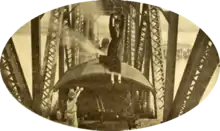
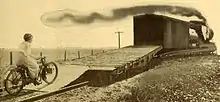
| Year | Title | Role | Production Company | Notes |
|---|---|---|---|---|
| 1912 | Ranch Girls on a Rampage | Ruth Roland's sister | Selig Polyscope Company | |
| 1913 | Old Moddingington's Daughters | Moddington's daughter | Vitagraph Studios | Short |
| A Girl of the Range | Short | |||
| 1914–1915 | The Hazards of Helen | Helen | Kalem Company | 63 episodes, (1915-1917) |
| 1915 | Man of God | Lubin Manufacturing Company | Short | |
| 1917 | Daughter of Daring | Helen | Kalem Company | 11 episodes |
| The Wrong Man | Bison Motion Pictures | Short | ||
| Ghost of Canyon Diablo | Short | |||
| Border Watch Dogs | Universal Pictures | Short | ||
| A Perilous Leap | Universal Pictures | Short | ||
| The Dynamite Special | Bison Motion Pictures | Short | ||
| The Little Outlaw | Pathe Exchange (dist) | Short | ||
| The Girl of Gopher City | Short | |||
| Trail Divided | Pathe Exchange (dist) | Short | ||
| Saving the Fast Mail | Helen | Bison Motion Pictures | Short | |
| The End of the Run | Nona Durman | Universal Pictures | Short | |
| Fighting Mad | Mary Lambert | Universal Pictures | ||
| 1918 | Play Straight or Fight | Helen Rankin | Universal Pictures | Short |
| The Midnight Flyer | Helen Morgan | Universal Pictures | Short | |
| The Branded Man | Helen Ewing | Universal Pictures | Short | |
| The Pay Roll Express | Helen | Universal Pictures | Short | |
| Bawled Out | Century Films | Short | ||
| Danger Ahead | Universal Pictures | Short | ||
| Under False Pretenses | Universal Pictures | Short | ||
| The Fast Mail | Universal Pictures | Short | ||
| The Dead Shot | Universal Pictures | Short | ||
| The Silent Sentinel | Universal Pictures | Short | ||
| Captured Alive | Dolly Martin | Universal Pictures | Short | |
| The Robber | Universal Pictures | Short | ||
| Wolves of the Range | Universal Pictures | Short | ||
| 1919 | The Secret Peril | Universal Pictures | Short | |
| The Black Horse Bandit | Universal Pictures | Short | ||
| The Canyon Mystery | Universal Pictures | Short | ||
| Riding Wild | Universal Pictures | Short | ||
| Ace High | Universal Pictures | Short | ||
| The Rustlers (John Ford) | Postmistress – Nell Wyndham | Universal Pictures | Short | |
| Gun Law (John Ford) | Letty | Universal Pictures | Short | |
| Down But Not Out | Universal Pictures | Short | ||
| Loot | Maid | Universal Pictures | ||
| 1921 | No Man's Woman | The girl | Helen Gibson productions | |
| The Wolverine | Billy Louise | Spencer Productions | ||
| 1922 | Nine Points of the Law | Cherie Du Bois | Rainbow Film Company | |
| Thorobred | Helen | |||
| 1927 | Heroes of the Wild | Julia | Mascot Pictures Corporation | |
| 1928 | The Chinatown Mystery | Trem Carr Pictures | ||
| The Vanishing West | Mrs. Kincaid | Mascot Pictures Corporation | Serial, Ep. 10 The End of the Trail | |
| 1931 | The Lightning Warrior Ch. 1 The Drums of Doom | Pioneer woman & stunt double: Georgia Hale | Mascot Pictures Corporation | Serial, [ch 1-2] |
| The Cheyenne Cyclone | Townswoman | Willis Kent Productions | Uncredited | |
| 1932 | Human Targets | Mrs. Dale | Big 4 Film | Uncredited |
| Single-Handed Sanders | Judd's Wife | Uncredited | ||
| The Silver Lining | Dorothy Dent | Alan Crosland Productions | ||
| Law and Lawless | Mrs. Kelley / molly | Majestic Pictures | ||
| 1933 | King of the Arena | Circus cowgirl | Universal Pictures | Uncredited |
| 1934 | Wheels of Destiny | Settler's wife | Ken Maynard Productions | Uncredited |
| Rocky Rhodes | Townswoman | Buck Jones Productions | Uncredited | |
| The Way of the West | Townswoman | Empire Films | ||
| 365 Nights in Hollywood | Student actress | Fox Film Corporation | Uncredited | |
| 1935 | The Pecos Kid | Party Guest | Uncredited | |
| The Drunkard | Betty | Weiss Productions | ||
| Cyclone of the Saddle | Mrs. Carter | Weiss Productions | ||
| Bride of Frankenstein | Villager | Universal Pictures | Uncredited | |
| Fighting Caballero | Drusella Jenkins | Uncredited | ||
| Gun Play | Woman at Dance | Uncredited | ||
| Five Bad Men | Mrs. Swift | Sunset Studios | ||
| 1936 | Custer's Last Stand | Calamity Jane | Weiss Productions | Serial, [Chs. 4-7, 10] |
| The Lawless Nineties | Townswoman | Uncredited | ||
| Lady of Secrets | Nurse | Columbia Pictures | Uncredited | |
| Last of the Warrens | Mrs. Burns | Supreme Pictures | Uncredited | |
| Winds of the Wasteland | Settler's Wife | Uncredited | ||
| Ride Ranger Ride | Wagon Trail Woman | Uncredited | ||
| Roarin' Lead | Adopter | Uncredited | ||
| 1937 | Jungle Jim | Mrs. Raymond | Universal Pictures | Serial, Uncredited |
| Git Along Little Dogies | Dwire's Wife | Uncredited | ||
| Range Defenders | Townswoman | Uncredited | ||
| Danger Valley | Nana Temple | Monogram Pictures | ||
| High, Wide, and Handsome | Paramount Pictures | Uncredited | ||
| Range Defenders | Woman in Saloon | |||
| 1938 | Condemned Women | RKO Pictures | Stunt, Uncredited | |
| The Old Barn Dance | Woman at Dance | Uncredited | ||
| Flaming Frontiers | Townswoman | Universal Pictures | Serial, [Ch. 9], Uncredited | |
| 1939 | Stagecoach | Girl in saloon | Walter Wanger Productions | Uncredited |
| Southward Ho | Mrs. Crawford | Uncredited | ||
| Spoilers of the Range | Woman at Dance | Serial, Uncredited | ||
| The Oregon Trail | Wagon train pioneer | Universal Pictures | Serial, [Ch. 6], Uncredited | |
| New Frontier | Mrs. Turner | Uncredited | ||
| The Marshal of Mesa City | Mrs. Bentley | Uncredited | ||
| Saga of Death Valley | Woman at Party | Uncredited | ||
| Cowboys from Texas | Settler | Uncredited | ||
| 1940 | Covered Wagon Trails | Woman in wagon train | Monogram Pictures | Uncredited |
| Deadwood Dick | Townswoman | Columbia Pictures | Serial, Uncredited | |
| Young Bill Hickok | Relay Station Woman | Uncredited | ||
| The Trail Blazers | Woman at Ceremony | Uncredited | ||
| 1941 | The Singing Hill | Emmy Walters | Uncredited | |
| Sheriff of Tombstone | Liza Starr | Republic Pictures | Uncredited | |
| Sunset in Wyoming | Fllod Victim | Uncredited | ||
| 1942 | The Sombrero Kid | Mrs. Lane | Uncredited | |
| The Valley of Vanishing Men | Helen | Columbia Pictures | Serial, Uncredited | |
| 1943 | The Blocked Trail | Townswoman | Uncredited | |
| 1944 | The Climax | Minor Role | Universal Pictures | Uncredited |
| 1946 | The Scarlet Horseman | Townswoman | Universal Pictures | Uncredited |
| 1949 | Cheyenne Cowboy | Cookie | Universal Pictures | Short |
| Outcasts of the Trail | Woman with Boy | Uncredited | ||
| 1950 | Crooked River | Mother | Lippert Pictures | Uncredited |
| Lonely Heart Bandits | Minor Role | Uncredited | ||
| Fast on the Draw | Mrs. Ellison | Lippert Pictures | ||
| Kansas Raiders | Minor Role | Universal Pictures | Uncredited | |
| 1951 | Hollywood Story | Self – old-time movie star | Universal Pictures | |
| The Dakota Kid | Woman at Party | Uncredited | ||
| 1952 | The Treasure of Lost Canyon | Mother | Universal Pictures | Uncredited |
| Ma and Pa Kettle at the Fair | Uncredited | |||
| Horizons West | Townswoman | Uncredited | ||
| 1953 | City That Never Sleeps | Woman | Republic Pictures | Uncredited |
| The Man from the Alamo | Woman on train | Universal Pictures | Uncredited | |
| 1954 | Ma and Pa Kettle at Home | Ranch wife | Universal Pictures | Uncredited |
| 1959 | The Horse Soldiers | Townswoman | Uncredited | |
| 1962 | The Man Who Shot Liberty Valance | Townswoman | John Ford Productions | Uncredited, (final film role) |
References
Notes
- Truitt, 1984.
- 1900 United States Census for Cleveland, Ohio
- Gibson and Kornick, 1968.
- Roach, Joyce Gibson, 1990.
- Gibson, Helen. unpublished letter December 24, 1966
- Wise, 1973.
- "Kalems for July". The Moving Picture World. July 8, 1916. Retrieved November 26, 2013.
Helen risked her life by a thrilling leap from the cab of one engine to the warning ropes strung around the tracks and a drop a second later to the top of a closely pursuing locomotive. A half day's rehearsal and many narrow escapes were encountered before the double-barreled feat could be accomplished.
- Acker, 1991.
- Lahue. 1964.
- Singer, 2001.
- 1920 United States Census for Los Angeles, California, Sheets No. 19A and 10B
- Lowe, 2005.
- L.A. Times, July 22, 1931.
- Baxter. 1974.
Bibliography
- Acker, Ally (1991). Reel Women: Pioneers of the Cinema 1896 to the Present. London: Batsford. ISBN 0-7134-6960-9.
- Baxter, John O. (1974). Stunt; the story of the great movie stunt men. Garden City, N.Y: Doubleday. ISBN 0-385-06520-5.
- Gibson, Helen; Mike Kornick (January 1968). "In Very Early Days, Screen Acting Was Often a Matter of Guts". Films in Review.
- "Horse Show Promising". L.A.Times. July 22, 1931.
- Lahue, Kalton C. (1964). Continued Next Week : A History of the Moving Picture Serial. Norman: University of Oklahoma Press.
- Lowe, Denise (2005). An encyclopedic dictionary of women in early American films, 1895-1930. New York: Haworth Press. ISBN 0-7890-1843-8.
- Roach, Joyce Gibson (1990). The Cowgirls. Denton, Tex: University of North Texas Press. ISBN 0-929398-15-7.
- Singer, Ben (2001). Melodrama and Modernity: early sensational cinema and its contexts. New York: Columbia University Press. ISBN 0-231-11329-3.
- Truitt, Evelyn Mack (1984). Who was who on screen. New York: Bowker. ISBN 0-8352-1906-2.
- Ware, Derek; Wise, Arthur (1973). Stunting in the Cinema. London: Constable. ISBN 0-09-459090-7.